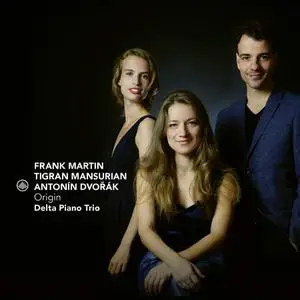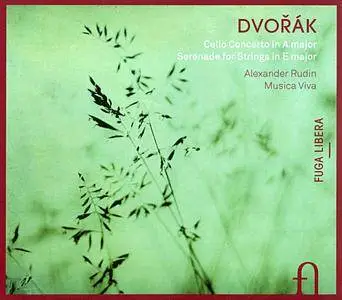Antonin Dvorak
Ofra Harnoy - Antonín Dvořák: Silent Woods Cello Concerto, etc (1995) Music
Posted by pgf000 at Oct. 20, 2010
Ofra Harnoy - Antonín Dvořák: Silent Woods Cello Concerto (1995)
(Prague Symphony Orchestra, cond. Sir Charles Mackerras, Michael Dussek - piano)
EAC Rip | FLAC+CUE+LOG | 273 MB | no scans
MP3 CBR 320kbps | 160 MB
Classical/Symphonic | RCA Victor Red Seal | 69:04
(Prague Symphony Orchestra, cond. Sir Charles Mackerras, Michael Dussek - piano)
EAC Rip | FLAC+CUE+LOG | 273 MB | no scans
MP3 CBR 320kbps | 160 MB
Classical/Symphonic | RCA Victor Red Seal | 69:04
"It is such an incredible work. It has everything; the passion, the virtuosity." - Ofra Harnoy, [about the Dvorak Cello Concerto]. Beside this masterpiece the disc also includes Slavonic Dances (8) for Piano 4 hands, Polonaise for Cello and Piano in A major, B 94, Rondo for Cello and Orchestra in G minor, Op. 94. Excellent recording quality.
Antonín Dvořák - Stabat mater für Soli, Chor und Orchester, op. 58 (2016) Music
Posted by v3122 at Jan. 13, 2016
Antonín Dvořák - Stabat mater für Soli, Chor und Orchester, op. 58 (2016)
Blu-Ray: MPEG-4 AVC 26994 kbps / 1920*1080i / 29,970 fps / 16:9 / High Profile 4.1
DTS-HD MA 5.0 / 48 kHz / 3338 kbps / 24-bit (DTS Core: 5.0 / 48 kHz / 1509 kbps / 24-bit)
LPCM Audio / 2.0 / 48 kHz / 2304 kbps / 24-bit
Classical / Choral | Clasart Classic | 01:22:01 | ~ 20.98 Gb
Blu-Ray: MPEG-4 AVC 26994 kbps / 1920*1080i / 29,970 fps / 16:9 / High Profile 4.1
DTS-HD MA 5.0 / 48 kHz / 3338 kbps / 24-bit (DTS Core: 5.0 / 48 kHz / 1509 kbps / 24-bit)
LPCM Audio / 2.0 / 48 kHz / 2304 kbps / 24-bit
Classical / Choral | Clasart Classic | 01:22:01 | ~ 20.98 Gb
Dvorák's haunting 'Stabat Mater' for solo voices, chorus and orchestra is not only the most famous work of church music by the Bohemian composer - it is also one of the most impressive ever settings of the medieval hymn in which Mary, the mother of Jesus, gives vivid expression to the pain she feels at the sight of her crucified son…
LPO, Neeme Jarvi, Soloists - Antonin Dvorak: Requiem, Op.89/B 165 (2009) 2 CDs Music
Posted by Designol at Sept. 28, 2023
Antonín Dvořák - Requiem, Op.89/B 165 (2009) 2 CDs
Lisa Milne, soprano; Karen Cargill, mezzo soprano; Peter Auty, tenor; Peter Rose, bass
London Philharmonic Orchestra and Choir; Neeme Järvi, conductor
EAC | FLAC | Image (Cue&Log) ~ 300 Mb | Mp3 (CBR320) ~ 193 Mb | Scans ~ 15 Mb
Classical, Choral, Sacred | Label: LPO | # LPO-0042 | Time: 01:24:41
Lisa Milne, soprano; Karen Cargill, mezzo soprano; Peter Auty, tenor; Peter Rose, bass
London Philharmonic Orchestra and Choir; Neeme Järvi, conductor
EAC | FLAC | Image (Cue&Log) ~ 300 Mb | Mp3 (CBR320) ~ 193 Mb | Scans ~ 15 Mb
Classical, Choral, Sacred | Label: LPO | # LPO-0042 | Time: 01:24:41
Never performed by the London Philharmonic Orchestra before, and rarely heard in concert at all, the Requiem by Antonín Dvorák captured on this CD from a live concert seems a near-forgotten masterpiece. Dvorák scholar Gervase Hughes cites this work for four soloists, chorus and orchestra as one of the composer's finest sacred creations, 'a deeply moving expression of faith on the part of a composer whose religious conviction never wavered'. It's a conviction stamped through the composer's illuminating, fervent score.
Anthony Marwood, Susan Tomes - Antonín Dvorák: Music for violin & piano (2011) Music
Posted by peotuvave at July 13, 2014
Anthony Marwood, Susan Tomes - Antonín Dvorák: Music for violin & piano (2011)
EAC Rip | Flac (Image + cue + log) | 1 CD | Full Scans | 262 MB
Genre: Classical | Label: Helios | Catalog Number: 55365
EAC Rip | Flac (Image + cue + log) | 1 CD | Full Scans | 262 MB
Genre: Classical | Label: Helios | Catalog Number: 55365
Dvorák's music for violin and piano comes from many periods in his career. An early Sonata in A minor of 1873 is lost. Of the works which do survive, several, including the Notturno and Four Romantic Pieces, are skilful arrangements of earlier works (the Notturno is a reworking of the central section of the E minor String Quartet, while the Four Pieces were originally written for viola and piano).
Bavarian Radio Symphony Orchestra & Choir, Mariss Jansons - Antonin Dvorak: Stabat Mater (2015) Music
Posted by Designol at May 19, 2025
Antonín Dvořák - Stabat Mater (2015)
Erin Wall, soprano; Mihoko Fujimura, mezzo; Christian Elsner, tenor; Liang Li, bass
Chor und Symphonieorchester des Bayerischen Rundfunks; Mariss Jansons, conductor
EAC | FLAC | Image (Cue&Log) ~ 315 Mb | Mp3 (CBR320) ~ 181 Mb | Scans included
Genre: Classical, Choral | Label: BR Klassik | # 900142 | 01:17:55
Erin Wall, soprano; Mihoko Fujimura, mezzo; Christian Elsner, tenor; Liang Li, bass
Chor und Symphonieorchester des Bayerischen Rundfunks; Mariss Jansons, conductor
EAC | FLAC | Image (Cue&Log) ~ 315 Mb | Mp3 (CBR320) ~ 181 Mb | Scans included
Genre: Classical, Choral | Label: BR Klassik | # 900142 | 01:17:55
Antonín Dvorák's Stabat Mater, Op. 58, written in the aftermath of the deaths of three of his children, is a sober and powerful work, inexplicably neglected and unlike any other work of choral music from the 19th century. Perhaps most performances don't capture its full weight, but this live recording from the Bavarian Radio Symphony Orchestra under Mariss Jansons, does so. There are many deep pleasures here. The orchestra's choir is extraordinary: rich yet without a hint of wobble and utterly clear in its sense of the text. Jansons keeps things at a deliberate pace that lets the music breathe and the currents of personal experience rise to the surface. The soloists, none terribly well known, are fine in their individual numbers, but absolutely transcendent in ensembles, nowhere more so that in the sublime "Quando corpus morietur" finale (track 10); there are a couple of other strong recordings of this work, but it seems likely that no one has ever matched this conclusion. The live recording from the Herkulessaal in Munich is impressively transparent and faithful to the spontaneity of the event. A superb Dvorák release.
Mandelring Quartett - Antonín Dvořák String Quartet, Op. 96, String Quintet, Op. 97 & Humoresques, Op. 101 (2025) [24/96] Vinyl & HR
Posted by pyatak at July 1, 2025
Mandelring Quartett - Antonín Dvořák String Quartet, Op. 96, String Quintet, Op. 97 & Humoresques, Op. 101 (2025) [24/96]
FLAC (tracks) 24-bit/56 kHz | Front Cover | Time - 01:19:55 minutes | 1.38 GB
Classical | Studio Master, Official Digital Download
FLAC (tracks) 24-bit/56 kHz | Front Cover | Time - 01:19:55 minutes | 1.38 GB
Classical | Studio Master, Official Digital Download
Antonin Dvorak's 'American' chamber music works are the fruits of a happy, carefree time. And this is reflected in the music: colourful, vibrant, imbued with the musical and scenic impressions he gathered in the bustling metropolis of New York and during his summer holidays in rural Iowa.
Isaac Stern, Emanuel Ax, McDonald, Laredo, Yo-Yo Ma - Antonin Dvorak: Piano Quartet No. 2; Romantic Pieces; Sonatina (1996) Music
Posted by Designol at Dec. 10, 2023
Antonín Dvořák: Piano Quartet No. 2; Romantic Pieces; Sonatina, Op. 100 (1996)
Isaac Stern, violin; Emanuel Ax, piano; Robert McDonald, piano; Jaime Laredo, viola; Yo-Yo Ma, cello
EAC | FLAC | Image (Cue&Log) ~ 300 Mb | Scans included
Genre: Classical | Label: Sony Classical | # SK 62597 | Time: 01:08:30
Isaac Stern, violin; Emanuel Ax, piano; Robert McDonald, piano; Jaime Laredo, viola; Yo-Yo Ma, cello
EAC | FLAC | Image (Cue&Log) ~ 300 Mb | Scans included
Genre: Classical | Label: Sony Classical | # SK 62597 | Time: 01:08:30
Antonin Dvorák's Piano Quartet No. 2 is one of the greatest chamber works of the 19th century (as are many of Dvorák's chamber compositions). Written in 1889 at the request of his publisher Simrock, it is a big, bold work filled with the Czech master's trademark melodic fecundity, harmonic richness, and rhythmic vitality. The first movement is a soaring, outdoor allegro with an assertively optimistic main theme accented by Czech contours and Dvorák's love of mixing major and minor modes. The Lento movement's wistful main theme is played with a perfect mixture of passion and poise by cellist Yo-Yo Ma. The music alternates between passages of drama and delicacy in this, one of Dvorák's finest slow movements in any medium. The Scherzo's stately waltz is contrasted by a lively, up-tempo Czech country dance. The finale is a high-stepping, high-spirited allegro with a strong rhythmic pulse that relaxes for the beautifully lyrical second subject.
Zemlinsky Quartet & Josef Kluson - Antonín Dvořák: Early Works for String Quartet (Remastered) (2007/2022) [24/48] Vinyl & HR
Posted by delpotro at May 12, 2022
Zemlinsky Quartet & Josef Kluson - Antonín Dvořák: Early Works for String Quartet (Remastered) (2007/2022)
FLAC (tracks) 24-bit/48 kHz | Front Cover & Digital Booklet | Time - 268:12 minutes | 2,8 GB
Classical | Label: Praga Digitals, Official Digital Download
FLAC (tracks) 24-bit/48 kHz | Front Cover & Digital Booklet | Time - 268:12 minutes | 2,8 GB
Classical | Label: Praga Digitals, Official Digital Download
The Czech Zemlinsky Quartet, which attended master classes by Vaclàv Bernašek (Kocian Quartet), Josef Klusoň (Pražàk) and Walter Levine (LaSalle), proposes the first recording of Dvořák’s youthful works for quartet (1862-74) taking into account the cuts made in the critical edition (Supraphon-Bärenreiter). Consequently, the works are better suited to concert performance and show off to best advantage the spontaneity and richness of their inexhaustible melodic inspiration, ‘apprentice works’ that prefigure the universality of the future ‘American’ Quartet of 1893.
Delta Piano Trio - Frank Martin, Tigran Mansurian, Antonín Dvořák: Origin (2022) Music
Posted by ArlegZ at July 7, 2022
Delta Piano Trio - Frank Martin, Tigran Mansurian, Antonín Dvořák: Origin (2022)
EAC | FLAC | Image (Cue & Log) ~ 240 Mb | Total time: 59:19 | Scans included
Classical | Label: Challenge Classics | # CC72901 | Recorded: 2021
EAC | FLAC | Image (Cue & Log) ~ 240 Mb | Total time: 59:19 | Scans included
Classical | Label: Challenge Classics | # CC72901 | Recorded: 2021
The first recording by the Delta Piano Trio on Challenge Classics. The Trio have chosen works by Frank Martin, Tigran Mansurian and Antonin Dvorak which span almost a century, are from very different cultures, but which are all based on folk tunes.
Alexander Rudin, Musica Viva - Antonin Dvorak: Cello Concerto in A major; Serenade for Strings in E major (2013) Music
Posted by Designol at Feb. 7, 2025
Antonín Dvořák: Cello Concerto in A major; Serenade for Strings in E major (2013)
Alexander Rudin, cello & direction; Musica Viva
EAC | FLAC | Image (Cue&Log) ~ 297 Mb | Mp3 (CBR320) ~ 152 Mb | Scans included
Genre: Classical | Label: Fuga Libera | # FUG714 | Time: 01:03:29
Alexander Rudin, cello & direction; Musica Viva
EAC | FLAC | Image (Cue&Log) ~ 297 Mb | Mp3 (CBR320) ~ 152 Mb | Scans included
Genre: Classical | Label: Fuga Libera | # FUG714 | Time: 01:03:29
For their fourth Fuga Libera-project, the Russian orchestra Musica Viva recorded one very famous, and one forgotten piece by Antonín Dvorak. The well-known piece is the Serenade for Strings in E major, written by Dvorak in 1875. It is believed that Dvorak took up this small orchestral genre because it was less demanding than the symphony, but allowed for the provision of pleasure and entertainment. The other piece is the Cello Concerto in A major. Unlike its brother, the B minor Concerto Op.104, this concerto has been more than overlooked. It was left un-orchestrated by Dvorak, existing only in piano-score form. It was only after his death that a few composers orchestrated this dazzling piece of music. Cello virtuoso Alexander Rudin, and Musica Viva let us taste from this magnificent forgotten treasure…
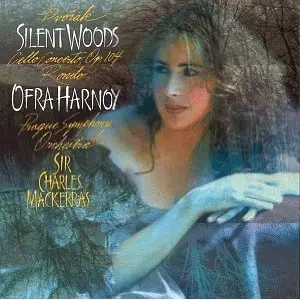
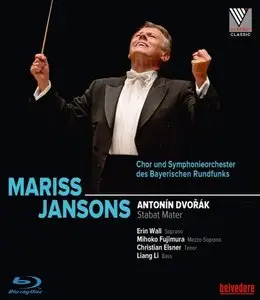
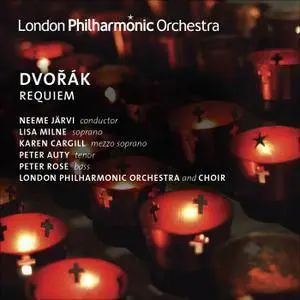
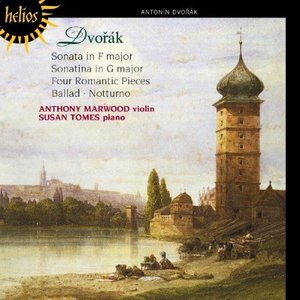
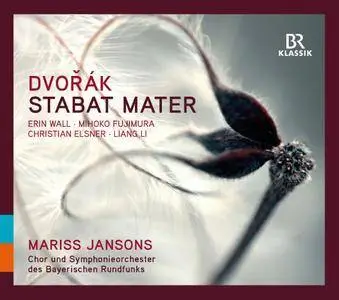
![Mandelring Quartett - Antonín Dvořák String Quartet, Op. 96, String Quintet, Op. 97 & Humoresques, Op. 101 (2025) [24/96]](https://pixhost.icu/avaxhome/de/de62/de62252bd3ea42c68d124421fe034e21-2583915638826486111_medium.webp)
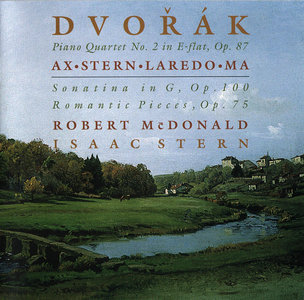
![Zemlinsky Quartet & Josef Kluson - Antonín Dvořák: Early Works for String Quartet (Remastered) (2007/2022) [24/48]](https://pixhost.icu/avaxhome/6a/35/0090356a_medium.jpg)
